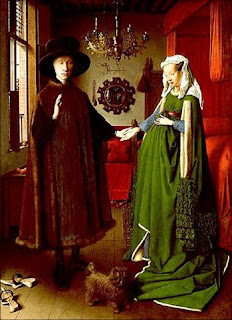Veronese, ‘Feast in the House of Levi’, 1573, oil on canvas

-A parody of 'The Last Supper'
-Accused by the Inquisition for heresy
-Later on changed the name of the painting to 'Feast in the House of Levi'
Caravaggio ‘The Calling of St. Matthew, 1599-1600, oil on canvas

-Develops the use of tenebrism, enhanced chiaroscuro,
-Creates a heightened sense of emotion
--------> These techniques used by Caravaggio (intense realism, tenebrism & use of large scale figures in the foreground) became known as Caravaggism or the Caravagesque technique and were copied throughout Europe
Bernini, ‘David’, 1623, Marble

-Dramatic compared to the other versions of David
-Diagonal composition
------> features of Baroque period.
Velazquez, ‘Las Meninas (The Maids of Honour),1656, oil on canvas, Spain

-this painting is a royal portrait, but it is also a self-portrait of the artist
- here he is dressed as a courtier, the Order of Santiago on his chest (added later) and the keys of the palace in his sash
-he shows his importance as an artist
-There are several theories on the interpretation of this painting
Cathedral of St. Martin, Utrecht, 16th c.

-Dutch society had high tolerance in religion
-They destoyed religious icons in art -> Iconoclasm
Rembrandt van Rijn, ‘The Anatomy Lesson of Dr. Nicolaes Tulp’, 1632, oil on canvas

-Rembrandt had studied science and nature
-Rembrandt had also studied Italian Renaissance art
-group portrait depicted here
-dramatic narrative scene
-sharp diagonal that pierces space from right to left uniting all of the figures
-use of tenebrism
-starting to reflect some of the new interest in science and medicine
Rachel Ruysch ‘Flower Still Life’, after 1700, oil on canvas

-Still life
-Diagonal
-Use of light
-Appears to depict a beautiful vase of flowers
-Moralizing message contained -> Vanitas
-The flowers are beginning to wilt and this acts as a reminder of the fleeting nature of beauty and of life

-A parody of 'The Last Supper'
-Accused by the Inquisition for heresy
-Later on changed the name of the painting to 'Feast in the House of Levi'
Caravaggio ‘The Calling of St. Matthew, 1599-1600, oil on canvas

-Develops the use of tenebrism, enhanced chiaroscuro,
-Creates a heightened sense of emotion
--------> These techniques used by Caravaggio (intense realism, tenebrism & use of large scale figures in the foreground) became known as Caravaggism or the Caravagesque technique and were copied throughout Europe
Bernini, ‘David’, 1623, Marble

-Dramatic compared to the other versions of David
-Diagonal composition
------> features of Baroque period.
Velazquez, ‘Las Meninas (The Maids of Honour),1656, oil on canvas, Spain

-this painting is a royal portrait, but it is also a self-portrait of the artist
- here he is dressed as a courtier, the Order of Santiago on his chest (added later) and the keys of the palace in his sash
-he shows his importance as an artist
-There are several theories on the interpretation of this painting
Cathedral of St. Martin, Utrecht, 16th c.
-Dutch society had high tolerance in religion
-They destoyed religious icons in art -> Iconoclasm
Rembrandt van Rijn, ‘The Anatomy Lesson of Dr. Nicolaes Tulp’, 1632, oil on canvas

-Rembrandt had studied science and nature
-Rembrandt had also studied Italian Renaissance art
-group portrait depicted here
-dramatic narrative scene
-sharp diagonal that pierces space from right to left uniting all of the figures
-use of tenebrism
-starting to reflect some of the new interest in science and medicine
Rachel Ruysch ‘Flower Still Life’, after 1700, oil on canvas

-Still life
-Diagonal
-Use of light
-Appears to depict a beautiful vase of flowers
-Moralizing message contained -> Vanitas
-The flowers are beginning to wilt and this acts as a reminder of the fleeting nature of beauty and of life
The Inquisition: feared organization within the Catholic world.
Anybody accused by the Inquisition was guilty until they could prove their innocence
Counter-Reformation: purpose was to reach and convert the masses of people who had strayed from the church
Tenebrism: strong chiaroscuro, using violent contrasts of light and dark
Iconoclasm : destroying religious icons and/or permitting their use
Anybody accused by the Inquisition was guilty until they could prove their innocence
Counter-Reformation: purpose was to reach and convert the masses of people who had strayed from the church
Tenebrism: strong chiaroscuro, using violent contrasts of light and dark
Iconoclasm : destroying religious icons and/or permitting their use
Vanitas : an image in which all the objects symbolize the transience of life, usually still lifes or genre subjects















